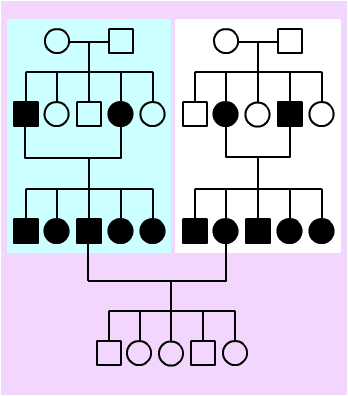Phenotypic vs. Genotypic Heterogeneity
By Leos Kral
Phenotype is defined as the appearance of a trait.
Genotype is defined as the combination of alleles or genes the affect a
particular trait. Generally, the genotype determines the phenotype.
Heterogeneity
simply means diversity. In the context of genetic analysis, phenotypic
heterogeneity simply means that there are diverse forms of a particular trait.
For example, let us consider the hypothetical trait hairy eyeballs from
the preceding two articles. When all dogs with hairy eyeballs are examined, it
turns out that there are several different forms of this condition. Some dogs
have only one hairy eyeball while others have two hairy eyeballs. In some dogs
hair begins to sprout on the eyeballs at birth and in other dogs the hair does
not grow until after the age of two years. Obviously, the trait hairy eyeballs exhibits
phenotypic heterogeneity because there is a diversity in the expression of that
trait.
The
question then becomes, how many genes are responsible for the hairy eyeball
trait? There could be just a single gene that is responsible for the presence
of hair on the eyeball(s) and all the different variations could be the result
of other genetic or environmental influences. That is, we could have a single
gene that specifies a single trait that shows phenotypic heterogeneity. It is
also possible, that there are multiple genes for hairy eyeballs, each
being responsible for one of the different forms. In the latter case the
phenotypic heterogeneity comes about because of genotypic heterogeneity.

The
above example shows a number of pedigrees exhibiting phenotypic heterogeneity
of hairy eyeballs. Note that regardless of which types of hairy eyeballs parents
in each breeding have, the offspring show all the different types. This would
suggest that hairy eyeballs is determined by a
single gene and that the phenotypic heterogeneity is probably due to
environmental influences.
If
the different forms of the hairy eyeball phenotype were the result of
genotypic heterogeneity, then it would be possible to see pedigrees like the
ones shown below where at least some forms of hairy eyeballs would breed true
(all offspring would look like the parents).

If
phenotypic heterogeneity of a trait exists, it is obvious that the question of
genetic heterogeneity must be addressed before any serious research into
finding a gene can begin. There is, however, another potential problem
illustrated by the figure below, where there is no phenotypic heterogeneity but
there is an underlying genetic heterogeneity.

Note
in the figure above that all affected individuals have identical types of hairy
eyeballs (both eyes hairy, growth started at birth). Two separate lines of dogs
show inheritance of hairy eyeballs as an autosomal
recessive trait ("rules": two normal parents can produce both
affected male and female offspring and two affected parents produce only
affected offspring). However, when affected individuals from these different
lines are mated, no affected offspring are produced. This scenario illustrates
genetic heterogeneity for a trait with no phenotypic heterogeneity. Two
different genes produce the same phenotype. When, as in the example above, two
affected individuals from these two lines are mated, the offspring obtain a
normal allele for one gene from one parent and a normal allele for the other
gene from the other parent and thus they have normal alleles for both genes and
a normal phenotype (no hair on eyeballs).
The
problem of genotypic heterogeneity underlying a single phenotypic trait with no
phenotypic heterogeneity is that at times a researcher has to combine data from
several different pedigrees to obtain statistically significant results. If the
pedigrees do not reflect the inheritance of the same gene, the whole research
effort may be compromised.
It is
important to know if a trait is caused by a single gene or by several different
genes before any laboratory research can begin to find the gene or genes
responsible for the trait. While it is not difficult to determine if phenotypic
heterogeneity is due to effects of other factors on the expression of one gene
or is the result of genetic heterogeneity, the determination does require a
large enough number of informative pedigrees for analysis and may also
necessitate that some test matings be carried out.
Determining if a particular trait that does not show phenotypic heterogeneity
is governed by a single gene or by several different genes is more difficult.
However, access to extensive genetic pedigree information may provide the
necessary clues. Participation of all aussies
in the Australian Shepherd Health Registry will ensure that a large enough
resource of genetic pedigree information will be available to make these types
of determinations possible.
Copyright 1998,
1999 Leos Kral. All rights reserved.